Archive:Europe 2020 indicators - education
- Data from June 2018. Most recent data: Further Eurostat information, Main tables. Planned article update: July 2019.
This article is part of a set of statistical articles on the Europe 2020 strategy. It provides recent findings on education in the European Union (EU).
The [Europe 2020 strategy] is the EU’s agenda for growth and jobs for the current decade. It emphasises smart, sustainable and inclusive growth as a way to strengthen the EU economy and prepare its structure for the challenges of the next decade.
Education is a key policy component of the [Europe 2020 strategy. The EU’s educational targets are interlinked with the other Europe 2020 goals as higher educational attainment improves employability, which in turn reduces poverty. The tertiary education target is furthermore interrelated with the research and development (R&D) and innovation target as investment in the R&D sector is likely to raise the demand for highly skilled workers.
Europe 2020 strategy target on education
The Europe 2020 strategy sets out a target of ‘reducing the share of early leavers from education and training to below 10 % and increasing the share of the population aged 30 to 34 having completed tertiary education to at least 40 % by 2020.
Key messages
- Early leaving from education and training has been falling continuously in the EU since 2002, for both men and women. The fall from 17.0 % in 2002 to 10.6 % in 2017 represents steady progress towards the Europe 2020 target of 10 %.%.
- Half of the Member States have already reached their national targets for the rate of early leavers from education and training. Southern European countries made particularly strong progress between 2008 and 2017.
- Across the EU, rates of early leaving from education and training are generally higher for people who live in a country different from the one they were born in.
- Educational attainment strongly influences labour market participation. In 2017, about 55.7 % of 18 to 24-year-old early leavers from education and training were either unemployed or inactive.
- Participation in early childhood education and care (ECEC) has grown more or less continuously in the EU since 2002. In 2016, 95.5 % of children between the age of four and the starting age of compulsory primary education participated in ECEC, exceeding the ET 2020 benchmark of a participation rate of at least 95 %.
- In 2015, about one-fifth of 15 year olds showed insufficient abilities in reading, maths and science. This is a step backward compared to 2012. As a result, the EU as a whole is seriously lagging behind in all three domains when it comes to progress towards the ET 2020 benchmark of less than 15 % of 15 year olds being low achievers. Low achievers are students who have failed to reach level 2 of the PISA test.
- Between 2002 and 2017, the share of 30 to 34 year olds having completed tertiary education grew continuously from 23.6 % to 39.9 %. Growth was considerably faster for women, who in 2017 were already clearly above the Europe 2020 target at 44.9 %. In contrast, among 30 to 34 year old men the share was 34.9 % in 2017.
- Educational attainment is the visible output of education systems. In general, younger people show higher educational levels than the older age group. Across all age groups, migrants born outside the EU (extra-EU migrants) have a much higher prevalence of low educational levels (ISCED 0–2) than people living in their country of birth or coming from another EU country (intra-EU migrants).
- Education and training plays an important role in improving employability. The employment rate of recent graduates (20 to 34 year olds having left education and training in the past one to three years) has dropped considerably due to the economic and financial crisis. It fell from 82.1 % in 2008 to 75.4 % in 2013. However, it has increased clearly since 2013, reaching 80.2 % in 2017.
- The share of adults participating in learning does not seem to be increasing fast enough to meet the ET 2020 benchmark of raising participation to at least 15 % by 2020. In the last three years, the share increased only marginally from 10.7 % to 10.9 % in 2017.
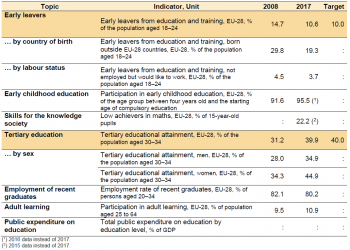
Source: Eurostat online data codes (t2020_40), (edat_lfse_02), (edat_lfse_14), (sdg_04_30), (sdg_04_40), (t2020_41), (sdg_04_50), (sdg_04_60) and (educ_uoe_fine06)
Main statistical findings
Continuous decrease in early school leaving
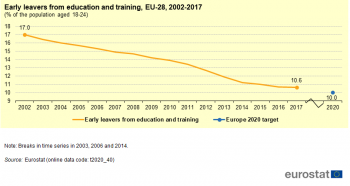
(% of the population aged 18–24)
Source: Eurostat online data code (t2020_40)
The EU regards upper secondary education as the minimum desirable educational attainment level for EU citizens. The skills and competences gained at this level are considered essential for successful labour market entry and as the foundation for adult learning. Therefore, the headline indicator ‘early leavers from education and training’ measures the share of the population aged 18 to 24 with at most lower secondary education and who were not involved in further education or training during the four weeks preceding the survey. Figure 1 shows that the share of early leavers has fallen continuously from 17.0 % in 2002 to 10.6 % in 2017, albeit more slowly in recent years. This trend mirrors reductions in almost all Member States for both men and women.
Overall, in the EU more men leave education and training early than women. This gap, which was 3.2 percentage points in 2017, has narrowed by 1.3 percentage points since 2004. However, for the second time since 2010, the gap has widened compared to the previous year. The rate for women is already below the headline target, with only 8.9 % leaving early in 2017.
At the country level, gender differences in 2017 were particularly strong in Spain, Latvia, Estonia and Malta. Slovakia, Bulgaria, Hungary and Romania were the only Member States where men were more likely to stay longer in education and training than women.
Substantial decreases in early leaving in southern European countries
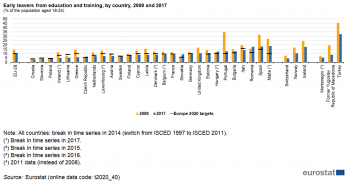
(% of the population aged 18–24)
Source: Eurostat online data code (t2020_40)
Reflecting different national circumstances, the overall EU target for early leavers from education and training has been transposed into national targets by all Member States except the United Kingdom. National targets range from 4 % for Croatia to 16 % for Italy. As shown in Figure 2, half of the Member States had already achieved their national targets in 2017.
Rates of early leaving vary widely across Member States. In 2017, the lowest proportion of early leavers was observed in some southern and eastern European countries (Croatia, Slovenia, Poland and Lithuania) and Ireland, with rates of less than 6 %. At the same time, some other southern and eastern countries, such as Malta, Romania and Spain, reported the highest shares in the EU, of slightly above 18 %.
Southern European countries also experienced strong falls in early leaving between 2008 and 2017, especially Portugal (from 34.9 % to 12.6 %), Spain (from 31.7 % to 18.3 %) and Malta (from 27.2 % to 18.6 %). A total of 18 Member States were already below the overall EU target of 10 % in 2017.
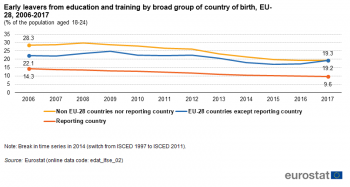
(% of the population aged 18–24)
Source: Eurostat online data code (edat_lfse_02)
Country of birth strongly influences the rate of early leaving across the EU (see Figure 3). People who live in a country different from the one where they were born are more likely to struggle to complete their education. Socioeconomic status underlies much of this difficulty, but issues associated with immigration such as language barriers and settling into a new environment are also at play, according to the Migration Policy Institute.
Early school leaving leads to severe problems in the labour market
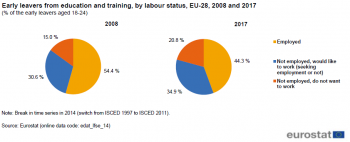
(% of the early leavers aged 18–24)
Source: Eurostat online data code (edat_lfse_14)
In general, low educational attainment — at most lower secondary education — influences other socioeconomic factors. The most important of these are employment, unemployment and the risk of poverty or social exclusion. Some of these relationships are also analysed in detail in other articles (see the articles on ‘Employment’ and ‘Poverty and social exclusion’).
Early leavers from education and training face particularly severe problems in the labour market. As Figure 4 shows, 55.7 % of the early leavers, were either unemployed or inactive in 2017. The situation for early leavers has worsened over time: between 2008 and 2017, the share of 18 to 24 year old early leavers who were not employed but who wanted to work grew from 30.6 % to 34.9 %. However, this increase has not been continuous, with the situation actually improving in recent years with the share falling from 37.0 % in 2016 to 34.9 % in 2017. For a further analysis on youth unemployment, see the article on ‘Employment’.
Participation in early childhood education and care has grown continuously
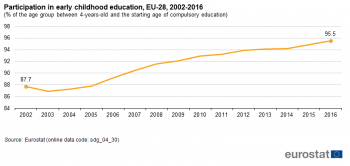
(% of the age group between 4 years old and the starting age of compulsory education)
Source: Eurostat online data codes (tps00179) and (sdg_04_30)
Early childhood education and care (ECEC) can bring wide-ranging social and economic benefits for individuals and for society as a whole. Quality education and care at this early stage provides an essential foundation for effective adult learning and future educational achievements. It also lays the foundations for later success in life in terms of well-being, employability and social integration. To realise these benefits, the EU aims to ensure that all young children can access and benefit from high-quality education and care (European Commission, 2014).
Participation in ECEC is crucial for preparing children for formal education, especially those from disadvantaged backgrounds. The aim is to reduce the incidence of early school leaving and thereby address one of Europe 2020’s headline targets on education. Investment in pre-primary education also offers higher medium- and long-term returns and is more likely to help children from low socioeconomic status than investment at later educational stages.
The Strategic Framework for Education and Training 2020 (ET 2020) recognises ECEC’s potential for addressing social inclusion and economic challenges. It has set a benchmark to ensure that at least 95 % of children aged between four and the starting age of compulsory education participate in ECEC. As Figure 5 shows, participation has been rising more or less continuously in the EU since 2002, reaching 95.5 % in 2016 and therefore exceeding the benchmark of 95 %.
Participation rates for children under three years old are much lower. In 2016, 32.9 % of children up to three years were cared for by formal arrangements (1 to 29 hours per week: 15.0 %, more than 30 hours per week: 17.9 %). Compared to 2010, this is an increase of 4.9 percentage points (1 to 29 hours per week: 14.0 %, more than 30 hours per week: 14.0 %) [1]. In 2002, the Barcelona European Council set objectives in this area: ‘Member States should remove disincentives to female labour force participation, taking into account the demand for childcare facilities and in line with national patterns of provision, to provide childcare by 2010 to at least 90 % of children between three years old and the mandatory school age and at least 33 % of children under three years of age’. This means the second objective had been almost reached by 2016.
Acquisition of skills such as reading, maths and science has taken a step backwards

(% of 15-year-old students)
Source: OECD/PISA online data code: (sdg_04_40)
Basic skills — whether the ability to read simple texts or perform easy calculations — provide the foundations for learning, gaining specialised skills and personal development. People also need these skills to fully participate in and contribute to society. The ET 2020 framework acknowledges the increasing importance of individual skills in the era of the knowledge-based economy. Therefore, one of the targets enshrined in the ET 2020 is to reduce the share of 15 year olds achieving low proficiency levels in reading, mathematics and science to less than 15 % by 2020.
In 2015, about every fifth of 15-year-old EU citizens showed insufficient abilities in reading, mathematics and science as measured by the OECD’s PISA study [2]. Test results were best for reading, with a 19.7 % share of low achievers, followed by science with 20.6 % and maths with 22.2 % (see Figure 6). According to the European Commission’s PISA 2015 report, the EU as a whole is seriously lagging behind the 2020 target to have less than 15 % of low achievers in each of the three basic skill areas. The report also shows that progress has taken a step backwards, with the rate of low achievers increasing since the PISA 2012 results by 4.0 percentage points in science, 1.9 percentage points in reading and 0.1 percentage points in maths.
In addition to basic skills in reading, maths and science, the ability of citizens to communicate in at least two languages besides their mother tongue has been identified as a key priority in the ET 2020 framework. Schools teach foreign languages in all Member States, making language learning a central element in every child’s school experience across Europe. On average, 15.5 % of pupils across the EU in primary education (ISCED level 1) were not engaged in foreign language learning at this level in 2015 [3]. This is an improvement on 2013, when this share stood at 18.3 %. Looking at students in lower secondary education (ISCED level 2), the share of pupils learning no foreign language dropped to 1.3 % across the EU in 2015. A majority of students in lower secondary education (58.8 %) were learning two or more foreign languages in 2015, and a further 39.8 % were learning one foreign language.
Increasing attainment at tertiary level
The share of tertiary graduates keeps on growing
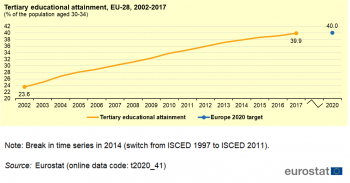
(% of the population aged 30–34)
Source: Eurostat online data code (t2020_41)
The second Europe 2020 education target — raising the share of the population aged 30 to 34 that have completed tertiary or equivalent education to at least 40 % — is monitored with the headline indicator on tertiary educational attainment of the same age group [4].
Figure 7 shows a steady and considerable growth in the share of 30 to 34 year olds who have successfully completed a university degree or other tertiary-level education since 2002. The share of 39.9 % in 2017 implies a growth of 16.3 percentage points since 2002, and means that the Europe 2020 target has almost been achieved three years early. Tertiary education attainment rate is considerably higher for women

(% of the population aged 30–34)
Source: Eurostat online data code (t2020_41)
Figure 8 shows a significantly widening gender gap among people with tertiary educational attainment across the EU. While in 2002 the share of tertiary graduates was almost similar for both sexes, the share of female graduates has grown at almost twice the rate until 2017, resulting in a gender gap of 10 percentage points in 2017. In this year, women outnumbered men significantly in all Member States. In fact, the gender gap was more than 10 percentage points in 21 countries, with Slovenia, Latvia and Lithuania showing the highest gaps of over 20 percentage points. Germany was the most ‘equal’ country with a gender gap of only 0.4 percentage points in favour of women.
All Member States have made significant progress in raising tertiary educational attainment
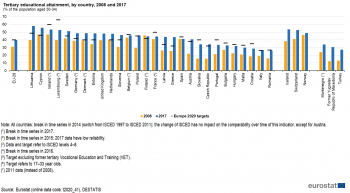
(% of the population aged 30 to 34)
Source: Eurostat online data code (t2020_41)
The increase in tertiary educational attainment levels across the EU is mirrored across all Member States. This to some extent reflects countries’ investment in higher education to meet the demand for a more skilled labour force (see article on ‘Employment’). Another factor is the shift to shorter degree programmes following the implementation of Bologna [5] process reforms in some countries.
National targets for tertiary education range from 26 % for Italy to 66 % for Luxembourg. Germany’s target is slightly different from the overall EU target because it includes post-secondary, non-tertiary attainment (ISCED level 4). For France, the target definition refers to the 17- to 33-year age group while for Finland the target excludes former tertiary vocational education and training (VET).
Figure 9 shows that in 2017, 15 countries had already achieved their national targets. Romania, Belgium and Hungary were close at less than two percentage points from their national targets while Luxembourg (13.3 percentage points), Ireland and Portugal (both 6.5 percentage points) were the most distant, respectively, below their targets.
In 2017, levels of tertiary educational attainment varied by a factor of about 2.2 across Europe. Northern and central Europe had the highest percentage of tertiary graduates, with 19 countries exceeding the overall EU target of 40 %. The lowest levels could be observed in Italy and Romania, which were both around 27 %.
At the same time, some eastern European countries experienced the strongest increases over the period 2008 to 2017. Changes were most pronounced in Slovakia and the Czech Republic where the shares almost doubled.

(%)
Source: OECD and Eurostat online data code (lfsa_pgaed)
Across other major world economies [6], tertiary attainment rates vary greatly, but all countries showed clear increases between 2008 and 2016 (see Figure 10). Korea experienced the biggest rise, of 12.1 percentage points, reaching a tertiary educational attainment rate of 70 % for the age group 25 to 34 in 2016. At 38.1 %, the EU had a significantly lower rate than some other industrialised countries.
The importance of education and adult learning for employability
People born outside the EU show higher prevalence of low education levels
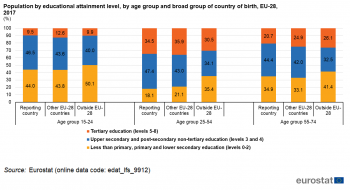
(%)
Source: Eurostat online data code (edat_lfs_9912)
Educational attainment is the visible output of education systems. Achievement levels can have major implications for many issues affecting a person’s life. This is reflected in adult participation in learning as well as in other aspects presented in the articles on ‘Employment’, and ‘Poverty and social exclusion’.
Figure 11 shows the educational attainment level of different population groups. The age group 25 to 54 shows higher educational levels than the 55 to 74 age group, which reflects the growing demand for a more highly skilled workforce in most parts of Europe over the past few decades. A more skilled workforce is expected to emerge as older generations leave the workforce and are replaced by younger, more highly educated ones. If labour markets do not provide adequate jobs this may result in higher levels of over-qualification and youth unemployment. For workers aged 55 and older, lower educational attainment levels, especially among women, highlight the importance of adult learning as a way to increase their employability and to help meet the Europe 2020 strategy’s employment target (see the article on ‘Employment’).
Across all age groups, migrants born outside the EU (extra-EU migrants) have a much higher prevalence of low educational levels (ISCED 0–2) than people living in their country of birth or coming from another EU country (intra-EU migrants). The reverse pattern can be observed for the medium education levels (ISCED 3–4). This rate is significantly lower for people from outside the EU, especially in the 25 to 54 age group. Interestingly, the tertiary education rate for extra-EU migrants is similar to or higher than the rate for native poeple, while the tertiary education rate for intra-EU migrants is higher than for the native population.
As shown in the article on ‘Employment’, the level of educational attainment is closely connected with the employment rate. People with higher educational levels are less affected by unemployment than people with lower educational levels. In 2017, 84.0 % of people with a tertiary education (ISCED 5–8) were employed, while this was only the case for 72.6 % of people with upper secondary and post-secondary non-tertiary education (ISCED 3–4). The situation is worse for people with less than primary, primary and lower secondary education (ISCED 0–2) with an employment rate of 54.9 % in 2017[7].
The employment rate of recent graduates has been increasing
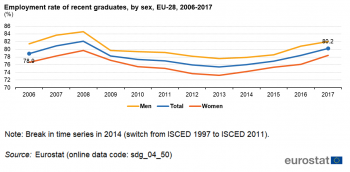
(%)
Source: Eurostat online data code (sdg_04_50)
The EU’s ET 2020 framework acknowledges the important role of education and training in raising employability. As a consequence, the EU aims to ensure that at least 82 % of recent EU graduates (20 to 34 year olds) should have found employment no more than three years after leaving education and training.
Figure 12 shows how severely the economic crisis has affected recent graduates. Between 2008 and 2013, employment rates among 20 to 34 year olds who have attained at least upper secondary education (ISCED 3), who have successfully completed their highest educational attainment in the past one to three years, and were not in further education or training in the four weeks preceding the survey, fell by 6.7 percentage points. In comparison, the decline in the overall employment rate for 20 to 64 year olds was ‘only’ 1.9 percentage points over the same period. However, 2013 marked a turnaround in this trend, with the share of employed recent graduates increasing in the following four years, reaching 80.2 % in 2017.
Participation in adult learning remains at a distance to the ET 2020 benchmark

(% of population aged 25 to 64)
Source: Eurostat online data code (sdg_04_60)
In addition to tertiary educational attainment, adult participation in learning is also crucial for providing Europe with a highly qualified labour force. Adult education and training covers the longest time span in the process of learning throughout a person’s life. After an initial phase of education and training, continuous, adult learning is necessary for improving and developing skills, adapting to technical developments, advancing careers or returning to the labour market (also see the article on ‘Employment’). In 2011, the European Council adopted a resolution on a renewed European agenda for adult learning. The EU’s ET 2020 framework also includes a benchmark that aims to raise the share of adults participating in learning to at least 15 %. This benchmark refers to people aged 25 to 64 who stated they received education or training in the four weeks preceding the survey.
After a rapid growth between 2002 and 2005, the share of the EU adults participating in learning slightly decreased and stagnated at around 9.5 % between 2005 and 2012. Influenced by the methodological change to the French Labour Force Survey [8], the share reached 10.7 % in 2013 and increased only slightly to 10.9 % in the following years.
Women are more likely to participate in adult learning than men. In 2017, the share of adult women engaged in learning was nearly 2 percentage points higher than that of men (11.8 % compared with 10.0 %).
Investment in future generations: the case of public expenditure on education
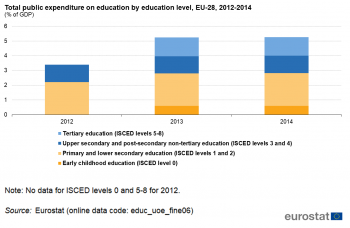
(% of GDP)
Source: Eurostat online data code (educ_uoe_fine06)
Public expenditure on education as a percentage of GDP is often considered an indicator of a government’s commitment to developing skills and competences. Generally, the public sector funds education either by directly bearing the current and capital expenses of educational institutions or by supporting students and their families with scholarships and public loans as well as by transferring public subsidies for educational activities to private firms or non-profit organisations. Both types of transactions together are reported as total public expenditure on education.
Figure 14 shows the total public expenditure on education for the EU as a share of GDP. In 2014, public expenditure was highest for primary and lower secondary education (levels 1–2) with 2.2 % of GDP. By contrast the smallest share of public expenditure on education went to early childhood education, with 0.6 % of GDP. The two remaining categories – upper secondary and post-secondary non-tertiary education (levels 3–4) and tertiary education (levels 5–8) – received a somewhat similar share of GDP, with 1.2 % and 1.3 %, respectively.
Data sources and availability
Indicators presented in the article:
- Early leavers from education and training’ (t2020_40)
- Breakdown by broad group of country of birth (edat_lfse_02)
- Breakdown by labour status (edat_lfse_14)
- Participation in early childhood education (sdg_04_30)
- Pupils between 4 years and the starting age of compulsory education - as % of the corresponding age group (educ_uoe_enra10)
- Underachievement in reading, maths or science: source OECD (sdg_04_40)
- Tertiary educational attainment (t2020_41)
- Breakdown by sex (t2020_41)
- Breakdown by country and other main economies (lfsa_pgaed)
- Population by educational attainment level, age and country of birth (edat_lfse_9912)
- Employment rate of recent graduates (sdg_04_50)
- Adult participation in learning (sdg_04_60)
- Total public expenditure on education by education level and programme orientation (educ_uoe_fine06)
Context
Education and training lie at the heart of the Europe 2020 strategy and are seen as key drivers for growth and jobs. The economic crisis along with an ageing population, through their impact on economies, labour markets and society, are two important challenges that are changing the context in which education systems operate [9]. At the same time, education and training help boost productivity, innovation and competitiveness.
Nowadays upper secondary education is considered the minimum desirable educational attainment level for EU citizens. Young people who leave education and training prematurely lack crucial skills and run the risk of facing serious, persistent problems in the labour market and experiencing poverty and social exclusion. Those early leavers from education and training who do enter the labour market are more likely to be in precarious, low-paid jobs and to draw on welfare and other social programmes. They are also less likely to be ‘active citizens’ or engage in adult learning.
In addition, tertiary education, with its links to research and innovation, provides highly skilled human capital (see the article on ‘R&D and innovation’). A lack of these skills presents a severe obstacle to economic growth and employment in an era of rapid technological progress, intense global competition and labour market demand for ever-increasing levels of skill. The Europe 2020 strategy, through its ‘smart growth’ priority, aims to tackle early school leaving and to raise tertiary education levels.
ET 2020 — the EU’s Strategic Framework for Education and Training 2020
The two Europe 2020 education targets also feature as EU benchmarks under the Strategic Framework for Education and Training 2020 (ET 2020). ET 2020 aims to foster European co-operation in education and training, providing common strategic objectives for the EU and its Member States up to 2020. ET 2020 covers the areas of adult participation in learning and mobility; quality and efficiency of education and training; equity, social cohesion and active citizenship; and creativity, innovation and entrepreneurship at all levels of education and training. To support the achievement of these objectives ET 2020 sets EU-wide benchmarks. In addition to the two Europe 2020 targets for education, there are another five benchmarks:
- Early education and care: At least 95 % of children between the age of four years and the age of starting compulsory primary education should participate in early childhood education.
- Underachievement in basic skills: The share of low-achieving 15 year olds in reading, mathematics and science should be less than 15 %.
- Employment rate of recent graduates: The share of graduates (20 to 34 year olds) having left education and training in the past one to three years who are employed and not in any further education and training should be at least 82 %.
- Adult participation in learning: An average of at least 15 % of adults should participate in learning.
- Learning mobility: On average in the EU, at least 20 % of graduates from higher education and at least 6 % of 18 to 34 year olds with an initial vocational qualification should have spent some time studying or training abroad.
See also
Further Eurostat information
Publications
Main tables
Dedicated section
Methodology / Metadata
- Towards robust quality management for European Statistics - Communication from the Commission to the European Parliament and the Council COM(2011) 211 final
Other information
- Regulation (EC) No 223/2009 of 11 March 2009 on European statistics
External links
Notes
- ↑ Data stem from the EU-SILC survey, data source: Eurostat (online data code: (ilc_caindformal))
- ↑ PISA is an international study that was launched by the OECD in 1997. It aims to evaluate education systems worldwide every three years by assessing the competencies of 15-year-old students in the key subjects: reading, mathematics and science. The data presented here refer to pupils showing skills below proficiency level 2 on the PISA scale.
- ↑ Data source: Eurostat (online data code: (educ_uoe_lang02))
- ↑ Educational attainment is defined according to the International Standard Classification of Education (ISCED). Tertiary educational attainment refers to ISCED 2011 level 5–8 (for data as from 2014) and to ISCED 1997 level 5–6 (for data up to 2013).
- ↑ The Bologna process put in motion a series of reforms to make European higher education more compatible, comparable, competitive and attractive for students. Its main objectives were: the introduction of a three-cycle degree system (bachelor, master and doctorate); quality assurance; and recognition of qualifications and periods of study (source: Education and training statistics introduced).
- ↑ The data in Figure 11 refers to the 25–34 age group, because the OECD database does not include the 30–34 age group that is used for the Europe 2020 target.
- ↑ Data source: Eurostat (online data code: (tepsr_wc120)) For further information see section 1.2.6 of the article on `Employment`.
- ↑ INSEE, the French Statistical Office, has carried out an extensive revision of the questionnaire of the Labour Force Survey. The new questionnaire was used from 1 January 2013 onwards. It impacts significantly the level of various French LFS-indicators.
- ↑ For further information on the impact of demographic ageing on the labour force, see the article on `Employment`.